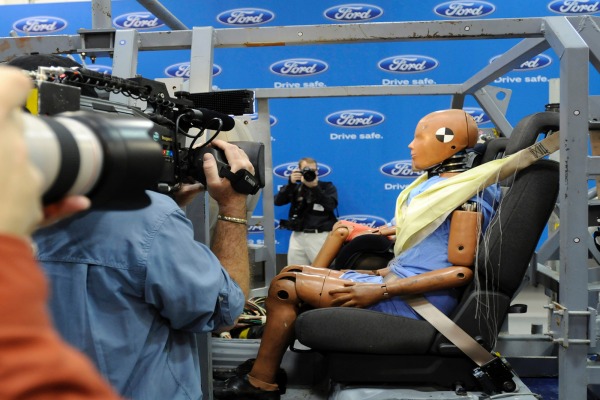
Ford introduced inflatable rear seatbelts in the 2011 Ford Explorer and promoted them as a safety feature for rear-seat occupants, especially children and older adults. They are now offered by Ford in several more models and in some Lincoln vehicles. Mercedes-Benz also offers an inflatable rear seatbelt in some models.
For parents who need to secure infant seats and boosters, however, inflatable seatbelts can pose a challenge. Most car safety seat makers still warn parents not to use them to secure infant or booster seats.
What They Do
The inflatable rear seatbelts are in Ford's Edge, Flex, Fusion and F-150 as well as Lincoln's MKT, MKX and MKZ. Mercedes offers its version as standard equipment on S600 models and as an option on other S-Class sedans.
"The advanced restraint system is designed to help reduce head, neck and chest injuries for rear-seat passengers, often children and older passengers who can be more vulnerable to such injuries," Ford said in a press release at the introduction of the technology.
The inflatable belt, noticeably thicker than a conventional seatbelt, deploys in milliseconds when a crash occurs, according to Ford. It lessens impact by distributing crash force energy across five times more of the rider's torso than a traditional belt, the carmaker says. Ford has offered to sell the technology to other companies, but did not elaborate on whether others have taken it up on the offer.
Inflatable Seatbelts and Car Safety Seats
Soon after the launch of the first inflatable rear seatbelts, many car safety seat makers issued warnings for parents not to use the new inflatable belts with their child safety seats or boosters, citing a lack of testing. Since the initial Ford launch of the seatbelts, a few additional makers have approved the use of the inflatable belts with some or all of their seats, although most still advise parents not to use the inflatable seatbelts to secure the child safety seats. SafeKids USA polled car seat makers about whether their seats should be used with the inflatable seatbelts and maintains a list of car seat makers' policies.
Some companies' decisions may have changed recently, however, so it's a good idea to check directly with the carmaker, via the toll-free number or its website. The Car Seat Lady website also has addressed user questions about appropriate safety seats for inflatable seatbelts.
Car Seat Makers Cautious
The hesitation about recommending the use of the inflatable belt in conjunction with child safety seats appears to stem from a lack of widespread research, not reports of specific mishaps. Safety experts at the University of Michigan Transportation Research Institute have not studied the issue directly, says Francine Romine, an institute spokesperson.
Car seat manufacturers are likely concerned that the inflating seatbelt could adversely affect the car seat, since federal tests don't include these newer options, experts say.
Safety Studied by Ford but Not by NHTSA
The inflatable seatbelts were tested before the Explorer launch, according to Ford. The booster seat tests included both boy and girl test dummies of various weights. Ford tested rear-facing and forward-facing infant seats, with and without the base. It also tested convertible seats.
Government safety officials from the National Highway Traffic Safety Administration (NHTSA) say they cannot endorse the use of inflatable seatbelts with child safety seats, nor speak to their effectiveness, as they have not studied the systems.
Advice for Parents
Those car seat manufacturers that advise against using the inflatable belts with their infant seats recommend using the child restraint anchorage system, Lower Anchors and Tethers for Children, (LATCH) instead. If car safety seat manufacturers recommend against using the inflatable belts with their booster seats, they suggest moving the booster to a position that has a standard three-point seatbelt. The inflatable seatbelts typically are offered on outboard second-row seats, but not the center. NHTSA offers how-to videos on its site for various ways to install car safety seats.